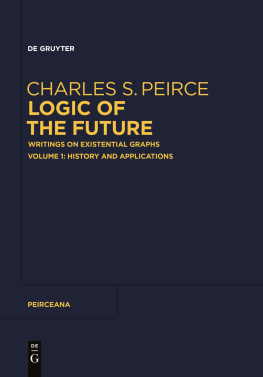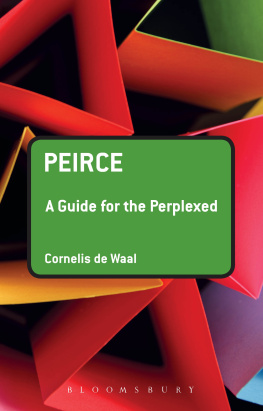Acknowledgments
Christian J. W. Kloesel and other staff members at the Peirce Edition Project in Indianapolis have been generous and supportive to a newcomer to the work of editing Peirce. Not only their personal generosity but their superb multi-volume edition Writings of Charles S. Peirce: A Chronological Edition have been important in completing this much smaller project, as is indicated in the source attributions preceding many of the selections below.
When I began this project, it was my understanding that no other Peirce anthologies were imminent. As matters now stand, however, Indiana University Press will be publishing a Peirce anthology at about the same time as this one is published. In light of that fact, I am grateful to Indiana University Press for granting, in this one instance and in return for a fee, permission to reproduce this volumes first ten selections from volumes 1-3 of The Writings of Charles S. Peirce: A Chronological Edition edited by Edward C. Moore, Max H. Fisch, Christian J. W. Kloesel et al. Material from Peirces manuscripts is published by permission of the Department of Philosophy of Harvard University. The manuscripts themselves are located in the Charles S. Peirce Papers at the Houghton Library at Harvard.
Albert Anderson, Vincent Colapietro, George Cotkin, David Hollinger, Christopher Hookway, and Bruce Kuklick kindly offered comments, either on the manuscript or on my initial proposal for this book. Christian J. W. Kloesel read both the proposal and the manuscript. I alone, of course, am responsible for the final result.
A generous stipend from the Babson College Board of Research enabled me to begin the project in the summer of 1989. Most of the work was done in congenial circumstances at the University of Manchester during the 1989-90 academic year, thanks to the members of the American studies department there and also to Graham Bird of the philosophy department. For making possible the year at Manchester I am grateful to Robert Burchell, to the Fulbright Commission in London, and to the Council for the International Exchange of Scholars. I am grateful to Diane Collins for preparing the line drawings.
As always, the love and patience of Carol, Johanna, and Benjamin Hoopes were essential.
Peirce on Signs

The Peirce Geodetic Monument in Indianapolis, Indiana, is used as a marker in satellite surveys conducted by the National Oceanic and Atmospheric Administration. Employed for much of his adult life by NOAAs ancestor organization, the U.S. Coast and Geodetic Survey, Peirce was one of the foremost geodesists of his day. (Courtesy of the Dean of the School of Liberal Arts at Indiana University-Purdue University at Indianapolis.)
Introduction
Charles Sanders Peirce (18391914) was born and raised in the most intellectually advantageous circumstances offered by nineteenth-century America. Benjamin Peirce, his father, was professor of mathematics and astronomy at Harvard and a preeminent American scientist who served many years with the United States Coast and Geodetic Survey. The talented parent recognized his sons great gifts and devoted many hours to training Charless mental facility and powers of concentration. After Charless graduation from Harvard, Benjamin arranged for his Coast Survey employment, which lasted for thirty years. Charles probably also owed to his father an assistantship at the Harvard Observatory from 1869 to 1872, which resulted in his only book published in his lifetime, Photometric Researches (1878). In these positions Charles not only made lasting, internationally recognized contributions to geodesy and astronomy but gained the closest practical familiarity with scientific method of any American philosopher.
As with Peirces science, so too did his philosophy owe something to his fathers early assistance. Charles recalled in old age that before I came to mans estate, being greatly impressed with Kants Critic of Pure Reason, my father... pointed out to me lacunae in Kants reasoning which I should probably not otherwise have discovered.Consequences of Four Incapacities, and Grounds of Validity of the Laws of Logicand his 1871 review of Frasers edition of The Works of George Berkeley, was one of the most important and thorough challenges to the Cartesian tradition since it came to dominate Western philosophy in the seventeenth century.
That a life begun so well should end in poverty and ruin is tragic, but it also lends poignancy to one of the basic thrusts of Peirces semioticthat self-knowledge is no easy affair. By comparison with other nineteenth-century intellectuals, Peirce married early, at twenty-three, to Zina Fay, the daughter of the Episcopal bishop of Vermont. The marriage was unhappy. In 1875, when Peirce was in the middle of a scientifically successful but financially disastrous year of gravitational work in Europe, Zina sailed home alone, and they eventually divorced. Unaccompanied when he next visited Europe in 1877, Peirce occupied himself during the voyage by writing the first of his famous Popular Science essays on the logic of science. That essay, The Fixation of Belief, concluded that the genius of a mans logical method should be loved and reverenced as his bride (159). The seriess second essay, How to Make Our Ideas Clear, pointedly likened an obscure idea mistakenly cherished to the fabulous German Melusina (164)Zinas given name.







